Tropical plants are famous for their vibrant colors and rich leaves. If you are planning to turn your home or garden into a tropical paradise, you have many beautiful plants to choose from as they thrive warm and humid environment.
In this blog post, we will discover some of the best indoor and outdoor plants. They can bring the essence of a tropical rainforest into your space. Whether you desire large leafy plants or colorful flowers, there’s something for everyone. Let’s explore how these bright plants can transform your environment and create a relaxing, tropical atmosphere.
Indoor Tropical Plants
Indoor tropical plants can bring greenery, warmth, and a sense of calm to your living space. These plants can flourish in the controlled conditions of your home, often resembling the environment of their native tropical rainforest. These plants can improve air quality and create a bright, inviting space. Here are the ten stunning tropical plants that are perfect for indoor settings.
Monstera Deliciosa
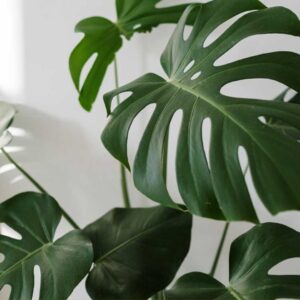
Monstera, also known as the Swiss cheese plant, is named for its large, heart-shaped leaves that feature natural holes. This plant can thrive indoors with indirect sunlight and regular watering. Its unique appearance enhances the overall look of any room.
To care for Monstera
- Water it when the top inch of soil is dry.
- Make sure it has good drainage to prevent overwatering.
- They can grow quite large, so give them enough space to spread.
With just a few steps of proper care, Monstera will flourish and become a beautiful focal point in your home. It helps improve air quality and its vibrant leaves will brighten your space, creating a more inviting atmosphere.
Bird of Paradise
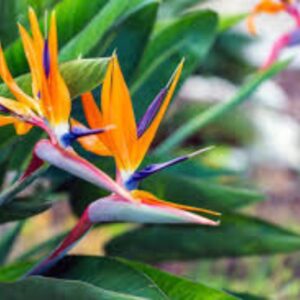
The Bird of Paradise is an elegant plant known for its large, banana-like leaves. It can bloom indoors under the right care, showcasing bright orange and blue flowers that look like a bird in flight. The Bird of Paradise can be a beautiful centerpiece in any room, and its flowers add a stunning touch when they bloom.
To care for Bird of Paradise
- The plant needs plenty of indirect sunlight and warmth to thrive.
- They can tolerate some direct sunlight, which helps promote blooming.
- If you’re growing them outdoors, full sun is ideal for encouraging blooms, but they can also handle partial shade.
- Place it near a bright window where it can soak up the light.
- Water it regularly but be careful not to overwater.
- Water thoroughly when the top 1-2 inches of soil are dry.
- During the growing season (spring and summer), keep the soil consistently moist but not soggy.
Fiddle Leaf Fig
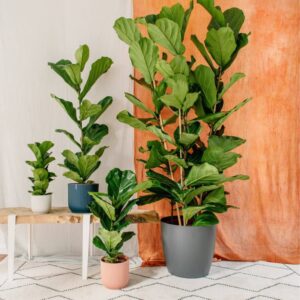
Peace Lily
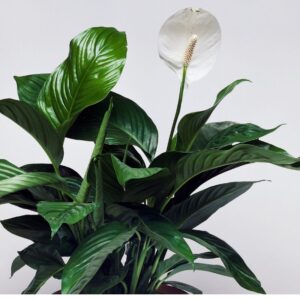
Peace lilies are known for their deep green leaves and beautiful white spathes. These are low-maintenance and even help purify the air, making them great for indoors. Peace lilies can flourish and add a fresh, vibrant feel to your home. They enhance your decor, making them an excellent choice for any room.
To care for Peace Lilies
- Just give them moderate light and they will reward you with their beautiful blooms.
- Water when the soil feels dry.
- Ensure the pot has drainage to prevent waterlogging.
Tropical Pitcher Plant
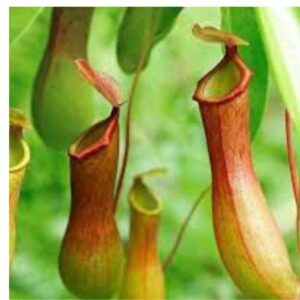
The tropical pitcher plant is a fascinating carnivorous plant that blooms in high humidity. Its leaves grow into unique cup-shaped “pitchers” that trap insects, making it an interesting addition to your indoor garden. These plants can add a touch of the exotic to your space and spark interest in their unique feeding habits.
How does it adapt?
The leaves transform into cup-shaped traps filled with digestive enzymes. When the insects attract to the pitcher, they slip and fall into the liquid inside. The plants use these enzymes to break down the insects, enabling them to absorb vital nutrients such as nitrogen and phosphorus.
This adaptation allows it to thrive in nutrient-poor soils by absorbing nutrients from trapped insects, where traditional sources of nutrients are scarce. They can thrive in environments by capturing and digesting insects, that would be challenging for many other plants.
To care for Tropical Pitcher Plant
- Caring for them is relatively easy; they prefer bright, indirect light and high humidity.
- With the right conditions, your tropical pitcher plant will flourish, creating a stunning focal point in your home.
- Keep the soil consistently moist but not soggy, using distilled, rainwater, or deionized water to avoid harmful minerals.
Anthurium
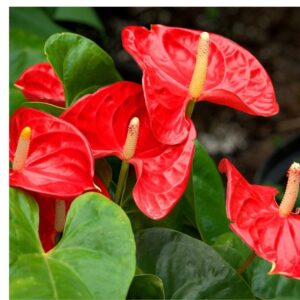
Anthuriums are famous for their shiny, heart-shaped leaves and vibrant flowers in red, white, or pink. These striking plants thrive in bright, indirect light, which helps their colors stand out. They also love humid conditions, making them perfect for bathrooms or kitchens.
To keep your anthurium healthy, place it in an area with plenty of filtered sunlight. This will encourage strong growth and beautiful blooms. Additionally, maintaining humidity levels will help the plant flourish. With the right care, anthuriums can be a stunning addition to your indoor garden, bringing a cheerful touch to any space.
To care for Anthurium
- To keep your anthurium healthy, place it in an area with plenty of filtered sunlight.
- Anthuriums thrive in high humidity.
- Mist the leaves regularly or use a humidifier to maintain moisture levels.
- Use a well-draining potting mix to support healthy root growth; a mix formulated for tropical plants is ideal.
With the right care, anthuriums can be a stunning addition to your indoor garden, bringing a cheerful touch to any space.
Snake Plant ( Mother-in-law’s tongue)
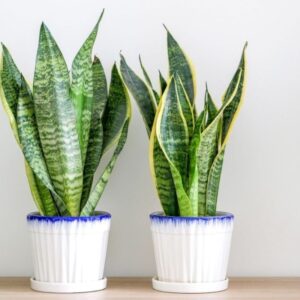
The snake plant, commonly known as mother-in-law’s tongue, is hardy with upright, sword-shaped leaves. This plant is perfect for beginners, as it requires minimal care and can adapt to various indoor conditions.
One of its benefits is its ability to thrive in low light, making it suitable for dimly lit rooms or spaces where other plants might struggle. Its beautiful foliage adds elegance to any space, with leaves that can grow several feet tall. The snake plant is also known for its air-purifying qualities, helping to improve indoor air quality by filtering out toxins.
To care for Snake Plant
- Position your snake plant in bright, indirect light, as it can also tolerate low light.
- Avoid direct sunlight, which can scorch the leaves.
- Water when the top inch of soil feels dry.
- Be cautious not to overwater, as snake plants are prone to root rot.
- Ensure the pot has drainage holes to prevent water accumulation.
By following these care tips, your snake plant will thrive and remain a beautiful addition to your home!
Calathea
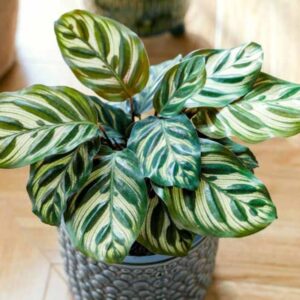
Calatheas are admired for their beautifully patterned leaves, which feature striking designs and vibrant colors. These plants prefer warm and humid environments, making them perfect for indoors. They prefer bright, indirect light to maintain their vibrant foliage, although they can adapt to lower light conditions. One of the most alluring aspects of calatheas is their movement; their leaves close up at night and reopen in the morning, a behavior known as nyctinasty. This unique feature brings charm and vitality to any indoor space, making calatheas both visually appealing and engaging to care for.
To care for Calathea
- Place your calathea in bright, indirect light.
- Avoid direct sunlight, as it can scorch the leaves.
- Keep the soil consistently moist but not soggy.
- Water when the top inch of soil feels dry, and use distilled or rainwater if possible.
With proper care regarding humidity and light, calatheas can thrive and add stunning beauty to your home.
ZZ Plant
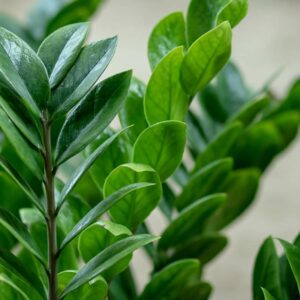
The ZZ plant is a favorite for indoor spaces because of its tolerance to thrive in low light and endure drought conditions. Its shiny, waxy leaves create a sleek, modern touch to any space. This hardy plant requires minimal care, making it perfect for busy lifestyles or beginners. The ZZ plants adapt well to different environments, thriving in both dim corners and bright areas. Its unique style and resilience not only beautify your home but also create a refreshing environment. Whether placed in a living room, office, or bedroom, this plant is a perfect choice for adding effortless greenery.
To care for ZZ Plant
- Position your ZZ plant in bright, indirect, or low light, as it can adjust to different lighting conditions.
- Water the plant when the top inch of soil feels dry; avoid overwatering, as it is drought-tolerant.
- Use well-draining soil to prevent root rot; a cactus or succulent mix is ideal.
Outdoor Tropical Plants
If you’re fortunate enough to live in a warm climate or have access to a greenhouse, outdoor tropical plants can transform your garden into a rich and exotic paradise. These bright plants flourish in bright sunlight, thrive in humid conditions, and prefer well-drained soil. Their bold colors and unique appearances can create a stunning visual impact in any outdoor space.
Hibiscus
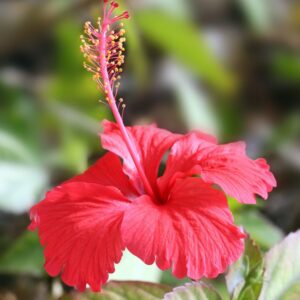
Hibiscus plants are celebrated for their stunning, colorful blooms that come in vibrant shades of red, pink, yellow, and orange. They create a tropical ambiance and can instantly brighten any garden with their eye-catching flowers. Hibiscus blooms in full sun, requiring at least six hours of direct sunlight each day to produce the most beautiful flowers. They require warm temperatures, making them ideal for tropical and subtropical gardens. Hibiscus plants can flourish, attracting pollinators like butterflies and hummingbirds. Their beauty and lush foliage make them a great addition to any outdoor space.
To care for Hibiscus
- Place hibiscus plants in full sun, ensuring they receive at least six hours of direct sunlight each day for optimal blooming.
- Keep the soil consistently moist but not soggy. Water regularly, especially during dry spells, to prevent stress on the plant.
- Use well-draining soil that retains some moisture but allows excess water to escape. A mix designed for tropical plants works well.
Banana Tree
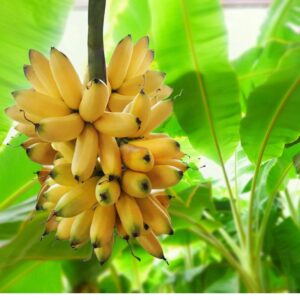
Banana plants bring a tropical vibe to any garden. These plants have large, vibrant leaves which create a lush, green backdrop. Banana plants do not consistently produce fruits. However, their impressive height and bold foliage enhance the visual appearance. These plants serve as a fascinating focal point and add texture to your garden.
In addition to their aesthetic benefits, banana plants thrive in warm and humid conditions. This makes them suited for tropical/subtropical climates.
To care for Banana Tree
- Place banana plants in full sun, as they thrive best with at least 6-8 hours of direct sunlight each day.
- Keep the soil consistently moist but not waterlogged. Water regularly, especially during hot and dry conditions, to ensure healthy growth.
- Use rich, well-draining soil that retains moisture. A mix that includes organic matter, such as compost, works well.
Plumeria
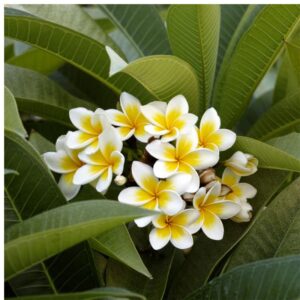
Plumeria, commonly referred to as Frangipani, is famous for its stunning, fragrant flowers. There are typically five petals. These exquisite blooms are not only visually captivating, they are widely used to create the traditional Hawaiian leis. Which symbolizes beauty and hospitality. Plumeria plants thrive in hot, sunny climates, making them perfect for tropical and subtropical gardens.
The vibrant colored flowers of these trees have an enchanting scent. These flowers come in a variety of shades, including white, pink, yellow, and red, adding a splash of color to your garden. Their ability to attract pollinators, such as bees and butterflies, further enhances their appeal.
To care for Plumeria Tree
- Place plumeria in full sun, as they require at least 6-8 hours of direct sunlight each day to thrive and produce abundant blooms.
- Water deeply but infrequently, allowing the soil to dry out between waterings. During the growing season (spring and summer), water more often, but reduce frequency in the fall and winter.
- Use well-draining soil, such as a cactus or succulent mix. Good drainage is essential to prevent root rot.
Bougainvillea
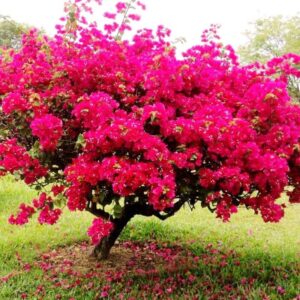
Bougainvillea is a beautiful climbing plant known for its striking, papery flowers that come in a variety of shades, which include pink, red, purple, and orange. These eye-catching blooms can transform any outdoor space. This makes them ideal for adding a splash of color.
This hardy plant thrives in warm climates, which enhances its flowering capabilities. Bougainvillea is a low-maintenance tree. Additionally, bougainvillea can be trained to grow in various shapes and styles. You can use them to cascade down a wall or climb them up a trellis.
To care for Bougainvillea
- Place bougainvillea in full sunlight for 5-6 hours daily to boost blooms and healthy growth.
- Water thoroughly, letting the soil dry between waterings. Water regularly in spring and summer, less in fall.
- Use well-draining soil, such as a cactus or succulent mix. Good drainage is crucial to prevent root rot.
Heliconia
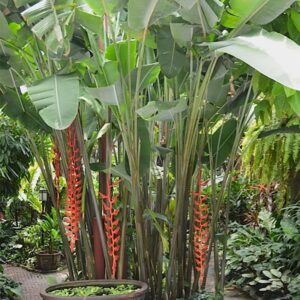
Heliconias, are also known as lobster claws because of their distinctive, claw-shaped flowers. These beautiful plants are known for their appearance. Heliconias thrive in full sun, requiring ample sunlight to produce their colorful blooms.
To flourish, they also need a warm, humid environment, making them ideal for tropical and subtropical climates. Their unique flowers attract pollinators, such as hummingbirds. Therefore, enhancing the overall biodiversity of your garden.
To care for Heliconias
- Place heliconias in full sun, ensuring they receive at least 6-8 hours of direct sunlight each day for optimal growth and blooming.
- Keep the soil consistently moist but not soggy. Water regularly, especially during dry spells, to maintain humidity around the plants.
- Use rich, well-draining soil that retains moisture but allows excess water to escape. A mix that includes organic matter, like compost, works well.
Conclusion
Tropical plants add vibrance and texture to both indoor and outdoor settings. Inside, plants such as the Monstera and tropical pitcher plants enhance your home with their distinctive shapes. While outside, vibrant blooms like hibiscus and bougainvillea can turn your garden into a tropical oasis. Whether you seek low-maintenance varieties or striking, attention-grabbing plants, there’s a tropical option that will fit perfectly in your space.
Thank you for reading, for more interesting articles visit our homepage.

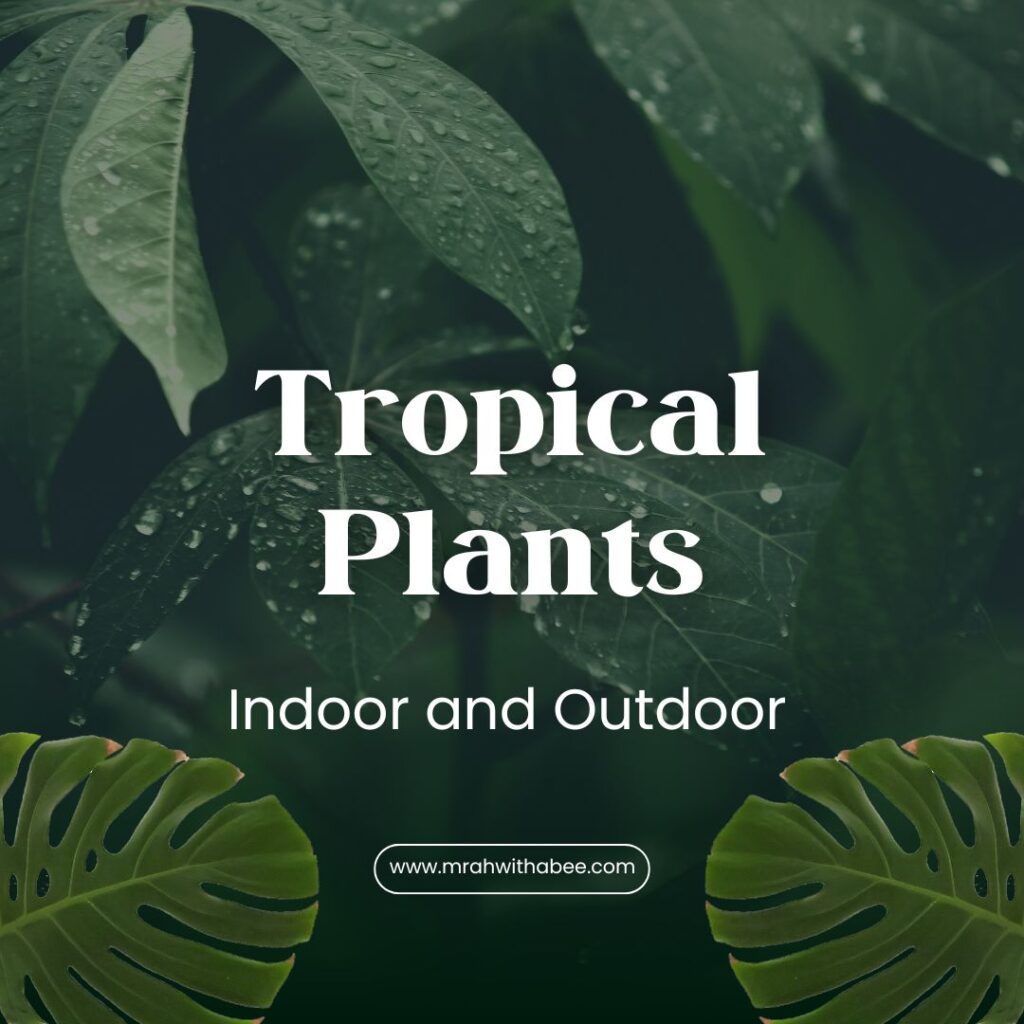
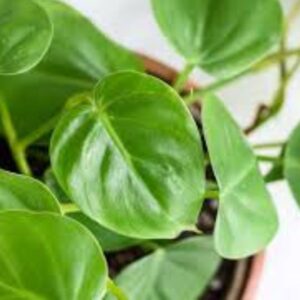


Pingback: Snake Plant Varieties: Your Guide to Choosing and Care